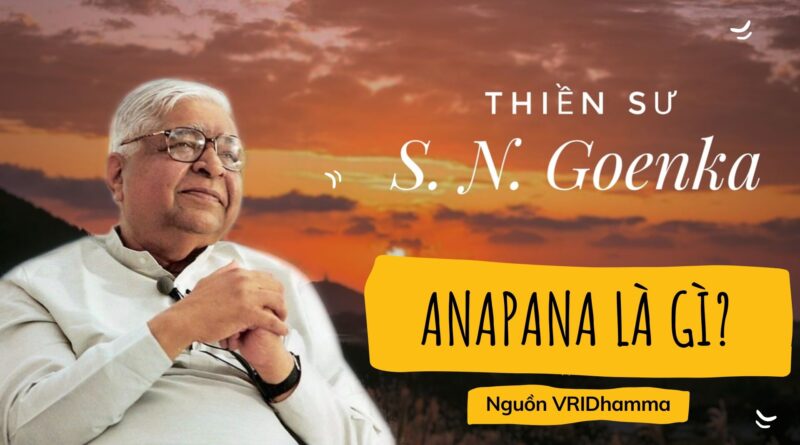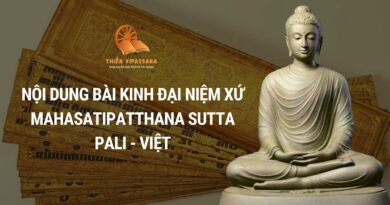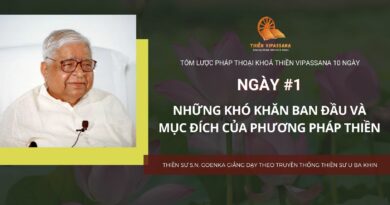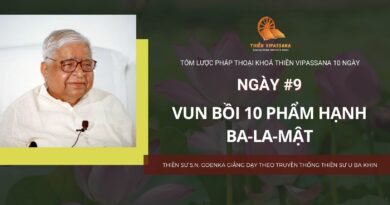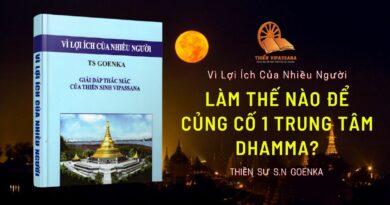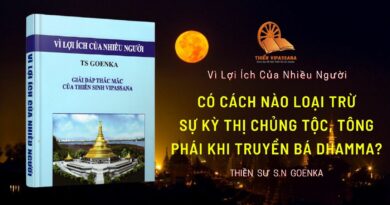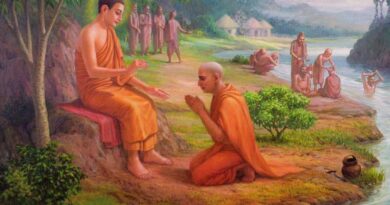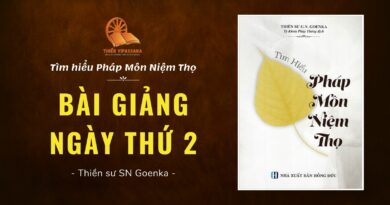Thiền Anapana là gì? What is Anapana?
इदं पुरे चित्तमचारि चारिकं, येनिच्छकं यत्थकामं यथासुखं।
तदज्जहं निग्गहेस्सामि योनिसो, हत्थिप्पभिन्नं विय अङ्कुसग्गहो॥
“This mind that wanders wherever it wishes, wherever it desires, wherever it sees pleasure, I will first make it steadfast. I will train it thoroughly like a mahout with a goad, train a wild elephant.” – Dhammapada 326
“Tâm trí này cứ đi lang thang bất cứ đâu mà nó muốn, bất cứ đâu nó mong cầu, bất cứ đâu nó cảm thấy dễ chịu, đầu tiên ta sẽ làm cho nó không dao động. Ta sẽ huấn luyện nó kỹ lưỡng như người quản tượng với chiếc gậy nhọn, huấn luyện một con voi hoang dại.” Dhammapada 326 (Kinh Pháp cú 326)
My Breath and I – Hơi Thở và Ta
Anapana is the first step in the practice of Vipassana meditation. Anapana means observation of natural, normal respiration, as it comes in and as it goes out. It is an easy to learn, objective and scientific technique that helps develop concentration of the mind.
Anapana là bước đầu tiên trong thực hành thiền Vipassana. Anapana có nghĩa là quan sát hơi thở tự nhiên, bình thường, khi nó đi vào, khi nó đi ra. Đây là phương pháp đơn giản, phổ quát và khoa học giúp phát triển sự định tâm (khả năng tập trung của tâm).
Observation of the breath is the ideal object for meditation because it is always available and it is completely non-sectarian. Anapana is very different from techniques that are based on the artificial regulation of breath. There are no rites or rituals involved in the practice or presentation of Anapana.
Quan sát hơi thở là đối tượng hướng tới của thiền định vì hơi thở luôn ở đó và hoàn toàn không có tính chất tông phái. Anapana rất khác biệt so với những phương pháp điều hòa hơi thở phi tự nhiên. Không có nghi thức hay nghi lễ mang tính tông phái trong việc thực hành hoặc lý thuyết ở Anapana.
Anapana provides a tool to deal with the fears, anxieties and pressures across all age groups, especially children. Besides helping to calm and concentrate the mind, Anapana helps people to understand themselves better and gives them an insight into the workings of their own minds. Because of its simplicity, the technique is easy to understand and practice.
Anapana đưa ra một công cụ để đối mặt với những sợ hãi, lo lắng và áp lực ở mọi lứa tuổi, đặc biệt là trẻ em. Bên cạnh việc giúp tâm trí bình an và tập trung, Anapana giúp con người hiểu về chính bản thân mình tốt hơn và cho họ cái nhìn sâu sắc về hoạt động của tâm trí. Vì tính đơn giản của nó, kỹ thuật này rất dễ hiểu và dễ thực hành.
Why Natural Respiration? Vì sao là hơi thở tự nhiên?
The goal of Vipassana meditation is not the concentration of the mind but to purify the mind completely, by eradicating all mental impurities such as anger, hatred, passion, fear. Vipassana is the analytical study of the mind and body (matter). To achieve this, one must gain complete knowledge of the body, of the mind and of the mental impurities at the experiential level, which is done with the help of respiration. Respiration acts like a bridge between the conscious and the unconscious mind and between voluntary and involuntary processes of the body.
Mục đích của thiền Vipassana không phải là định tâm mà là để hoàn toàn thanh lọc tâm, bằng cách diệt trừ tất cả các bất tịnh trong tâm như giận dữ, hận thù, đam mê, sợ hãi. Vipassana là sự khảo sát phân tích về tâm và thân (vật chất). Để đạt được điều này, ta phải hiểu biết đầy đủ về thân, tâm và các bất tịnh trong tâm ở mức độ kinh nghiệm (thực chứng), quá trình này được thực hiện với sự trợ giúp của hơi thở. Hơi thở là cầu nối giữa tâm ý thức và tâm vô thức, giữa các quá trình có chủ ý hay tự nhiên của cơ thể.
The first step of this technique is to develop awareness of the present reality. Life can really be lived only in the present. When one observes respiration, one begins to understand the nature of the mind. The mind is very fleeting, very fickle – this reality becomes very clear. It never stays in the present, constantly tries to escape into a past or future that is unattainable. The past moment is gone forever. Even in return for all the wealth in the world, one cannot bring back that moment. Similarly, one cannot live in the future. When the future becomes the present, only then can one live in it. One has not learned how to live – one has not learned the Art of living. By observing natural respiration, we slowly train our mind to live in present.
Bước đầu tiên của kỹ thuật này là phát triển nhận thức về thực tại đang hiện hữu. Cuộc đời là đáng sống chỉ khi ta sống trong hiện tại. Khi một người quan sát hơi thở, người đó bắt đầu hiểu bản chất của tâm. Tâm trí rất dao động, thay đổi liên tục – điều này trở nên rất rõ ràng. Tâm không bao giờ ở trong hiện tại, luôn liên tục trở về quá khứ hoặc hướng tới tương lai bất định nào đó. Khoảnh khắc trong quá khứ đã qua đi mãi mãi. Thậm chí ngay cả khi đổi bằng mọi sự giàu có trên đời, con người không thể mang khoảnh khắc ấy quay trở lại. Tương tự thế, con người cũng không thể sống trong tương lai. Chỉ khi nào tương lai trở thành hiện thực ở hiện tại, khi đó ta mới có thể sống trong đó. Người nào chưa học được cách sống với hiện tại, người đó chưa học được nghệ thuật sống. Bằng cách quan sát hơi thở tự nhiên, chúng ta từng bước rèn luyện tâm trí của mình để sống trong hiện tại.
Another reason for adopting natural incoming and outgoing breath as the object of concentration is that the rhythm of our respiration has an intimate natural connection with the negativities of the mind. When the mind is polluted and overpowered by any harmful negativity such as anger, fear, lust, envy or any other, we see that the rhythm of our respiration naturally becomes rapid and gross. When these negativities stop polluting the mind, the rhythm of respiration becomes slow and subtle. Observing the natural breath is a universal practice. Breath is breath, not a Hindu breath, a Muslim breath or a Christian breath. Thus, Anapana becomes universal.
Một lý do khác khi lấy hơi thở tự nhiên đi vào và đi ra làm đối tượng của sự định tâm đó là vì, nhịp điệu của hơi thở có mối liên hệ tự nhiên mật thiết với những bất tịnh của tâm trí. Khi tâm trí ô uế và bị áp đảo bởi bất kỳ phản ứng tiêu cực có hại nào như giận dữ, sợ hãi, ham muốn, đố kị hoặc bất kỳ điều gì khác, chúng ta thấy rằng nhịp điệu của hơi thở tự nhiên trở nên gấp gáp và thô thiển hơn. Khi những tiêu cực này dừng lại, nhịp thở dần chậm lại và vi tế hơn. Quan sát hơi thở tự nhiên là một phương thức phổ quát. Hơi thở là hơi thở, không phải hơi thở của Hindu giáo, hơi thở Hồi giáo hay hơi thở Thiên chúa giáo. Vì thế, Anapana trở nên phổ quát.
Difference between Vipassana and Anapana – Sự khác nhau giữa Vipassana và Anapana
The goal of Vipassana is to purify the mind of all impurities whereas the goal of Anapana is concentration of mind.
Mục đích của Vipassana là thanh lọc tâm khỏi mọi bất tịnh, trong khi đó mục tiêu của Anapana là định tâm.
Vipassana means “to see things as they really are”; it is a logical process of mental purification through self-observation. For self-observation, one penetrates one’s entire physical and mental structure with the clarity of insight. For this, we need a medium, a tool, which will lead us to the root level of the mind, from where the negativities and impurities arise – that medium is the breath. Observing the breath is called Anapana.
Vipassana có nghĩa là “nhìn thấy mọi thứ như nó đang thực sự là”; đó là một tiến trình khách quan của sự thanh lọc tâm thông qua tự quan sát. Để tự quan sát, người đó cần thâm nhập vào toàn bộ cấu trúc thể chất và tinh thần với sự nhận thức rõ ràng. Để làm được điều này, chúng ta cần một phương tiện, một công cụ, để đưa chúng ta đến tầng sâu của tâm trí, nơi phát sinh những tiêu cực và bất tịnh – phương tiện đó là hơi thở. Quan sát hơi thở được gọi là Anapana.
Anapana meditation is a way through which the restless fleeting mind can be drawn back to a particular object or base, thus bringing the mind under control. Just as an untamed calf must be tied to a stake to prevent it from wandering away, so also the mind must be tied down to the “stake” (the base of the nose) by the “rope” (the knowing of each incoming and outgoing breath) to make it calm and steady. Anapana meditation has its own immense benefits, but it is the means, not the end. It helps us to concentrate the mind, so that mind is calmer and more focused, thereby, better able to undertake the practice of Vipassana itself.
Thiền Anapana là con đường mà thông qua đó tâm trí vọng động có thể được đưa trở về một đối tượng hoặc điểm tựa cụ thể, khi đó tâm được kiểm soát. Giống như một con thú chưa được thuần hóa phải được buộc vào một chiếc cọc để nó không đi lang thang, cũng như thế, tâm phải được buộc vào “chiếc cọc” (phần cửa mũi) bởi sợi dây thừng (nhận biết về mỗi hơi thở ra vào) để khiến nó trở nên điềm tĩnh và an ổn. Thiền Anapana bản thân nó có những lợi ích to lớn, nhưng nó cũng chỉ là phương tiện, không phải là mục đích cuối cùng. Nó giúp ta định tâm, do vậy tâm trí bình an hơn và tập trung hơn, nhờ thế, có thể thực hành Vipassana được tốt hơn.
Anapana Courses – Các khóa Anapana
Initially, Anapana meditation was taught only as a part of the 10-day Vipassana course. However, Mr. S. N. Goenka, principal teacher of Vipassana meditation, decided to open the doors of Anapana to everybody, so that people can start taking initial steps on the path of Dhamma till the time they are ready to learn Vipassana, by attending a 10-day course. At present, Anapana can be learnt through one of the following ways:
Ban đầu, thiền Anapana chỉ như một phần của khóa học Vipassana 10 ngày. Tuy nhiên, Ngài SN Goenka, Thiền sư chính của Vipassana, đã quyết định mở cửa Anapana cho mọi người, để mọi người có thể bắt đầu thực hiện những bước đầu trên con đường Dhamma cho đến khi họ sẵn sàng học Vipassana, bằng cách tham dự khóa thiền 10 ngày. Hiện tại, Anapana có thể học được thông qua một trong những cách sau:
1. Children’s Courses – Khóa thiền Trẻ em
The ideal time to take the first steps of this mental training is in childhood. Besides helping children to calm and concentrate their minds, Anapana helps them to understand themselves better and gives them an insight into the workings of their own mind. They develop an inner strength which helps them to choose between right and wrong actions, and gain mastery over their own minds. Anapana provides them with a tool to deal with the fears, anxieties and pressures during childhood and adolescence. Because of its simplicity, children find the technique easy to understand and practice.
Thời điểm lý tưởng để bước những bước đi đầu tiên của việc huấn luyện tâm này là thời thơ ấu. Bên cạnh việc giúp trẻ điềm tĩnh và định tâm, Anapana giúp trẻ hiểu bản thân hơn và cho chúng cái nhìn sâu sắc về hoạt động tâm trí của chính mình. Những đứa trẻ phát triển được một sức mạnh nội tâm giúp phân biệt được các hành động đúng và sai, và làm chủ tâm trí của chúng. Anapana cung cấp cho trẻ em một công cụ để đối mặt với những nỗi sợ hãi, lo lắng và áp lực trong thời thơ ấu và thanh thiếu niên. Vì tính đơn giản của nó, trẻ em sẽ thấy phương pháp này dễ hiểu và dễ thực hành.
Vipassana International Academy holds regular Anapana courses at permanent Vipassana centers and rented sites in different countries for children between 8 to 16 years. Generally, separate courses are organized for the age groups, 8 to 12 years and 13 to 16 years. The duration of courses is 1 day. However, 2-3 days residential courses are also available to provide better continuity of practice.
Học viện Thiền Vipassana Quốc tế thường xuyên tổ chức các khóa học Anapana tại các trung tâm Vipassana chính thức và các địa điểm được thuê tại các quốc gia khác nhau cho trẻ em từ 8 đến 16 tuổi. Thông thường, các khóa học riêng biệt được tổ chức cho các lứa tuổi, từ 8 đến 12 tuổi và từ 13 đến 16 tuổi. Thời lượng của các khóa học là 1 ngày. Tuy nhiên, vẫn có những khóa nội trú 2-3 ngày để giúp việc thực hành được liên tục hơn.
2. Anapana in Schools under MITRA Upakram (Project) – Anapana trong Trường học theo Dự án MITRA Upakram
MITRA Upakram is an initiative of the Government of Maharashtra in association with Vipassana Research Institute to facilitate wholesome mental growth of school children. MITRA, which stands for MIND IN TRAINING for RIGHT AWARENESS also means DOST in Hindi or FRIEND in English. Under MITRA Upakram, schools in co-ordination with VRI arranges for its students to get initial training of 70 minutes of Anapana, through audio/video instructions of Mr. S. N. Goenka. After the initial training, the school children practice this technique daily for 10 minutes twice – before their first class, and after their last class.
MITRA Upakram là một sáng kiến của Chính quyền Maharashtra cùng với Viện Nghiên cứu Vipassana với mục đích hỗ trở phát triển tâm trí toàn diện ở học sinh. MITRA, viết tắt của MIND IN TRAINING for RIGHT AWARENESS (LUYỆN TÂM ĐỂ CÓ NHẬN THỨC ĐÚNG ĐẮN) cũng có nghĩa là DOST trong tiếng Hindi hoặc FRIEND trong tiếng Anh. Theo chương trình MITRA Upakram, các trường liên kết với VRI tổ chức thực hành Anapana trong 70 phút, thông qua các hướng dẫn âm thanh/video của Ngài S.N. Goenka. Sau lần huấn luyện đầu tiên đó, học sinh các trường thực hành phương pháp này hai lần mỗi ngày trong vòng 10 phút – trước tiết học đầu tiên và sau tiết học cuối cùng.
Under MITRA projects, school teachers get paid leave to attend 10-day Vipassana courses. MITRA
Theo các dự án MITRA, giáo viên của trường được nghỉ phép để tham gia các khóa học Vipassana 10 ngày.
3. Anapana Meditation for All – Thiền Anapana cho Tất cả mọi người
(a.) 70-Minute Anapana Session: The following link contains detailed audio instructions on Anapana meditation in various languages.
(a.) Thời khóa Anapana 70 phút: Các link dưới đây chứa các hướng dẫn audio chi tiết về thiền Anapana bằng nhiều ngôn ngữ khác nhau.
Tải file hướng dẫn thiền Anapana 70 phút – tiếng Anh
(b.) 20-Minute mini-Anapana Session: It is a condensed version of 70-minute Anapana session. Please refer the following link to follow audio/video instructions of Mr. S. N. Goenka. Please click on the links below to download audio files of mini-Anapana meditation in various languages:
(b.) Thời khóa mini-Anapana 20 phút: Đây là phiên bản thu gọn của thời khóa Anapana 70 phút. Vui lòng tham khảo link dưới đây để nghe hướng dẫn audio/video của Ngài S. N. Goenka. Vui lòng nhấp vào các link bên dưới để tải xuống các file âm thanh của thời thiền mini-Anapana bằng nhiều ngôn ngữ khác nhau:
Tải file hướng dẫn thiền Mini Anapana 20 phút – [Anh – Việt]
- Mini Anapana [25m 15s] (T.Anh)
- Group Sitting [10m 09s] (T.Anh)
- Thiền Metta [12m 09s] (T.Anh)
- Thiền Anapana 10 Phút (Anh-Việt)
- Lợi Ích Phương Pháp Anapana [25 Phút] (Anh-Việt)
Instructions for playing 70-minute and 20-minute Anapana sessions:
* This is to be played in a quiet hall or room suitable for meditation.
* Participants must agree to stay for the entire time of the session, observing noble silence and should maintain segregation of males and females with no physical contact.
* Participants can be anyone above the age of 10 years.
* The only instructions should be Goenkaji’s Mini Anapana recording. Neither the person hosting the session nor anyone else should give any other instructions, either live or recorded
* There should be no charge whatsoever for attending a Mini Anapana session.
Note: Please note that someone who has learnt Anapana from any of the above sources, will not be considered as an “Old Student” in this tradition. They can’t participate in any program designated “Only for Old Students”.
Hướng dẫn khi phát audio/video thời khóa Anapana 70 phút và 20 phút:
- Phát audio/video ở một không gian yên tĩnh thích hợp cho việc thiền định.
- Thiền sinh phải đồng ý ở lại trong toàn bộ thời gian của thời thiền, giữ sự im lặng thánh thiện và duy trì sự phân biệt nam nữ không có tiếp xúc thân thể.
- Thiền sinh có thể là bất cứ ai miễn là trên 10 tuổi.
- Sử dụng duy nhất bản ghi của Goenkaji về Mini Anapana. Bất kể người tổ chức hay bất cứ ai khác không được đưa ra hướng dẫn nào khác, dù trực tiếp hay được ghi lại.
- Không thu bất cứ khoản phí nào khi tham dự khoá Mini Anapana.
Lưu ý: Xin lưu ý rằng, người học Anapana từ nguồn ở trên sẽ không được coi là “Thiền sinh cũ” trong truyền thống này. Họ không thể tham gia vào bất kỳ chương trình nào được chỉ định “Chỉ dành cho thiền sinh cũ”.
Course Charges – Học phí
Please note that there should be no charge whatsoever, in any manner, for attending an Anapana session.
Xin lưu ý rằng không thu bất cứ khoản phí nào, dưới bất kỳ hình thức nào, khi tham dự Thời khóa Anapana.
Daily Practice – Thực hành hằng ngày
After learning the Anapana meditation from anyone of the above ways, it is essential to practice Anapana for a short period of at least 10-15 minutes each day, morning and evening, to get the true benefits of the technique.
Sau khi học thiền Anapana theo các hướng dẫn trên, điều cần thiết là thực hành Anapana trong một khoảng thời gian ngắn ít nhất 10 – 15 phút mỗi ngày, sáng và tối, để có được lợi lạc thực sự của phương pháp.
Benefits of practicing Anapana – Lợi ích của việc thực hành Anapana
Many students have reported the following benefits by the regular practice of Anapana Meditation:
* Effective tool to deal with the fears, anxieties and pressures
* Increased concentration of mind
* Improved awareness and alertness of the mind
* Memory becomes sharp
* Decision-making power improves
* Mastery over the mind
* Increased self-confidence
* Decreased agitation, fear, tension, nervousness and stress
* Increased capacity to work
* Better performance in studies, sports and extra-curricular activities
* Better ability to understand and express oneself
* Mind becomes healthy, wholesome and strong
* One becomes full of good wishes for others
Nhiều thiền sinh đã kể lại những lợi ích sau đây bằng việc thực hành thiền Anapana đều đặn:
- Công cụ hiệu quả để đối mặt với những nỗi sợ hãi, lo lắng và áp lực
- Tăng sự tập trung
- Cải thiện nhận thức và sự nhạy bén của tâm
- Cải thiện trí nhớ
- Gia tăng khả năng quyết định
- Làm chủ tâm trí
- Tăng sự tự tin
- Giảm kích động, sợ hãi, căng thẳng, lo lắng và stress
- Tăng khả năng làm việc
- Hiệu suất tốt hơn trong học tập, thể thao và các hoạt động ngoại khóa
- Khả năng hiểu và mô tả bản thân tốt hơn
- Tâm trí trở nên khỏe khoắn, lành mạnh và mạnh mẽ
- Con người trở nên tràn đầy thiện ý với những người khác
Nguồn: VRIDhamma.org
Video hướng dẫn thiền Anapana 10 phút (phụ đề t.Anh & t.Việt)
Audios hướng dẫn thiền Anapana & pháp thoại khoá thiền
Audio hướng dẫn thiền Anapana 70 phút bản T.Anh

